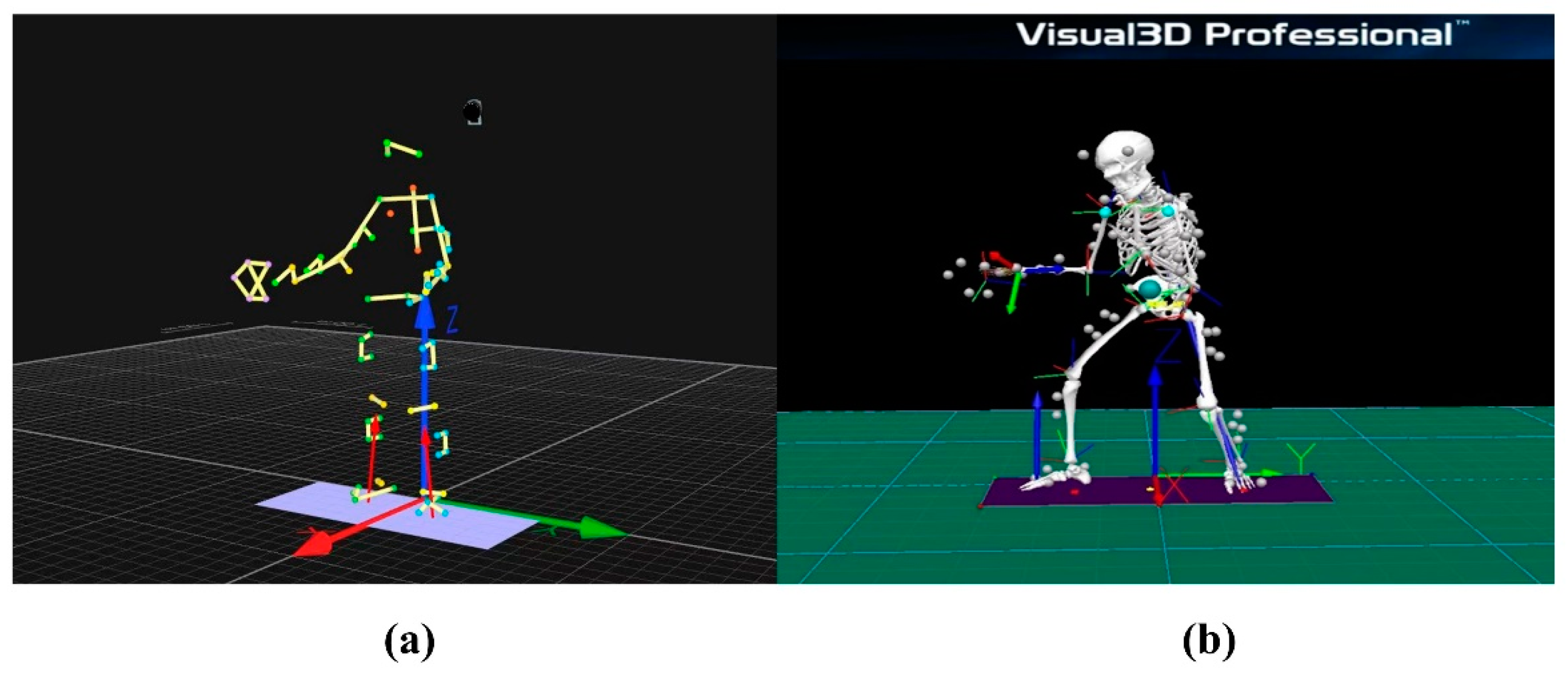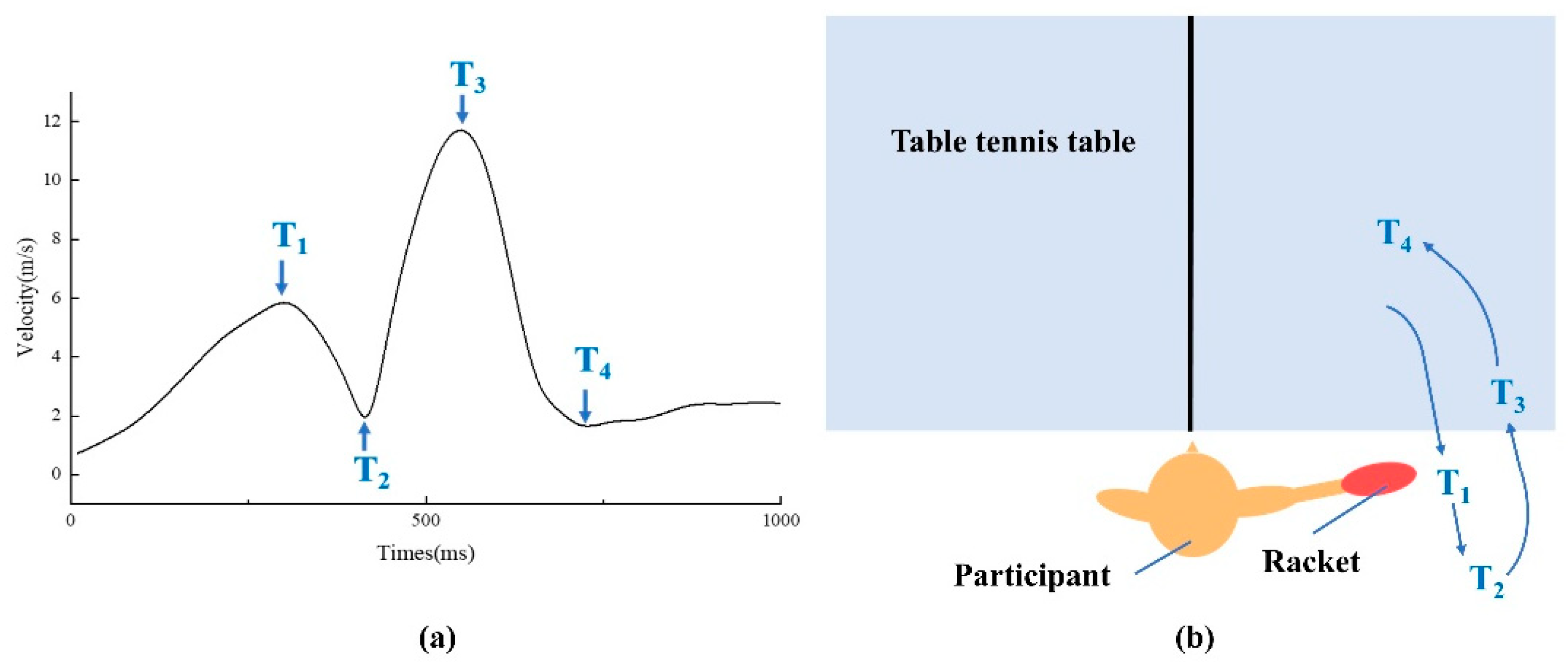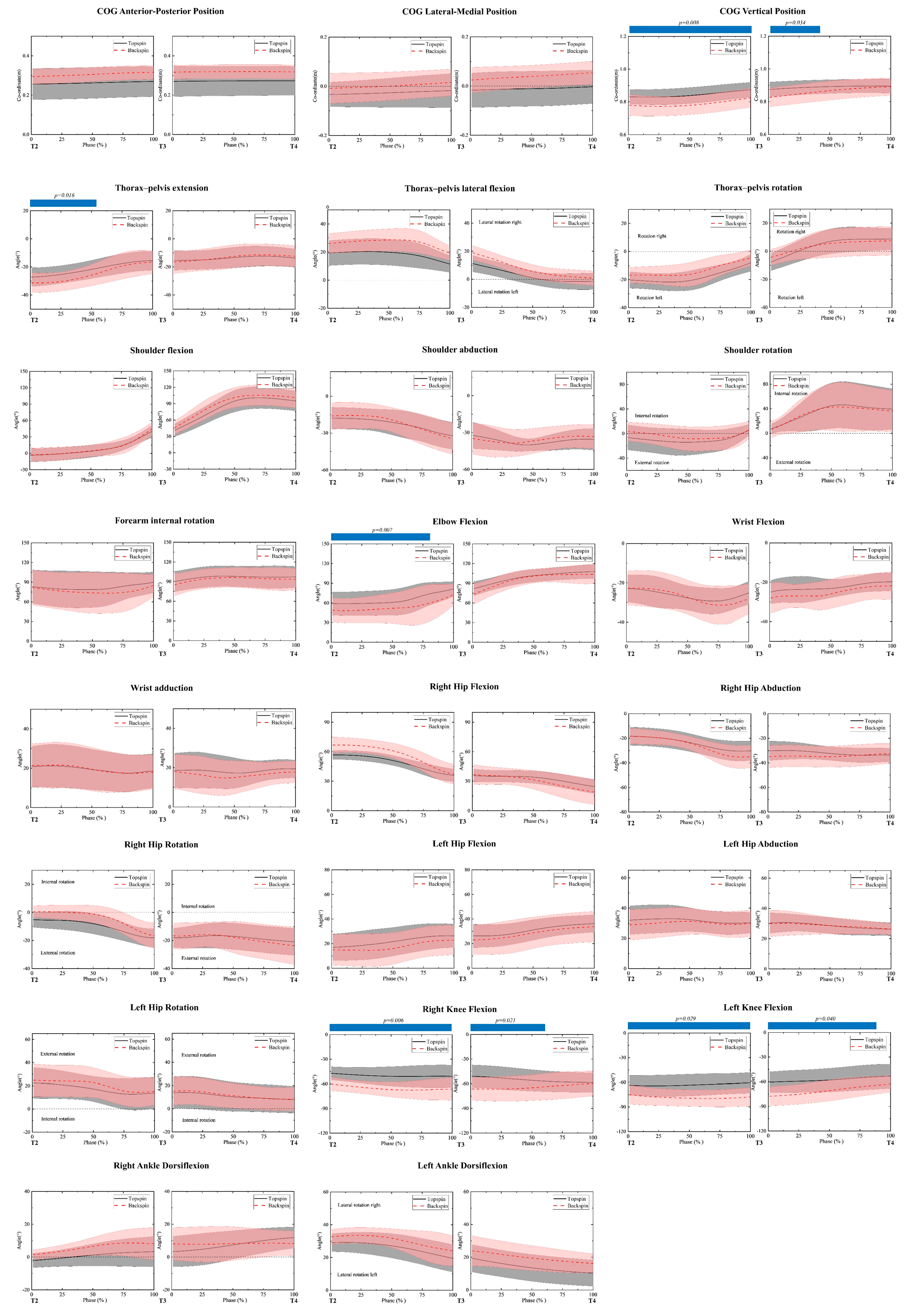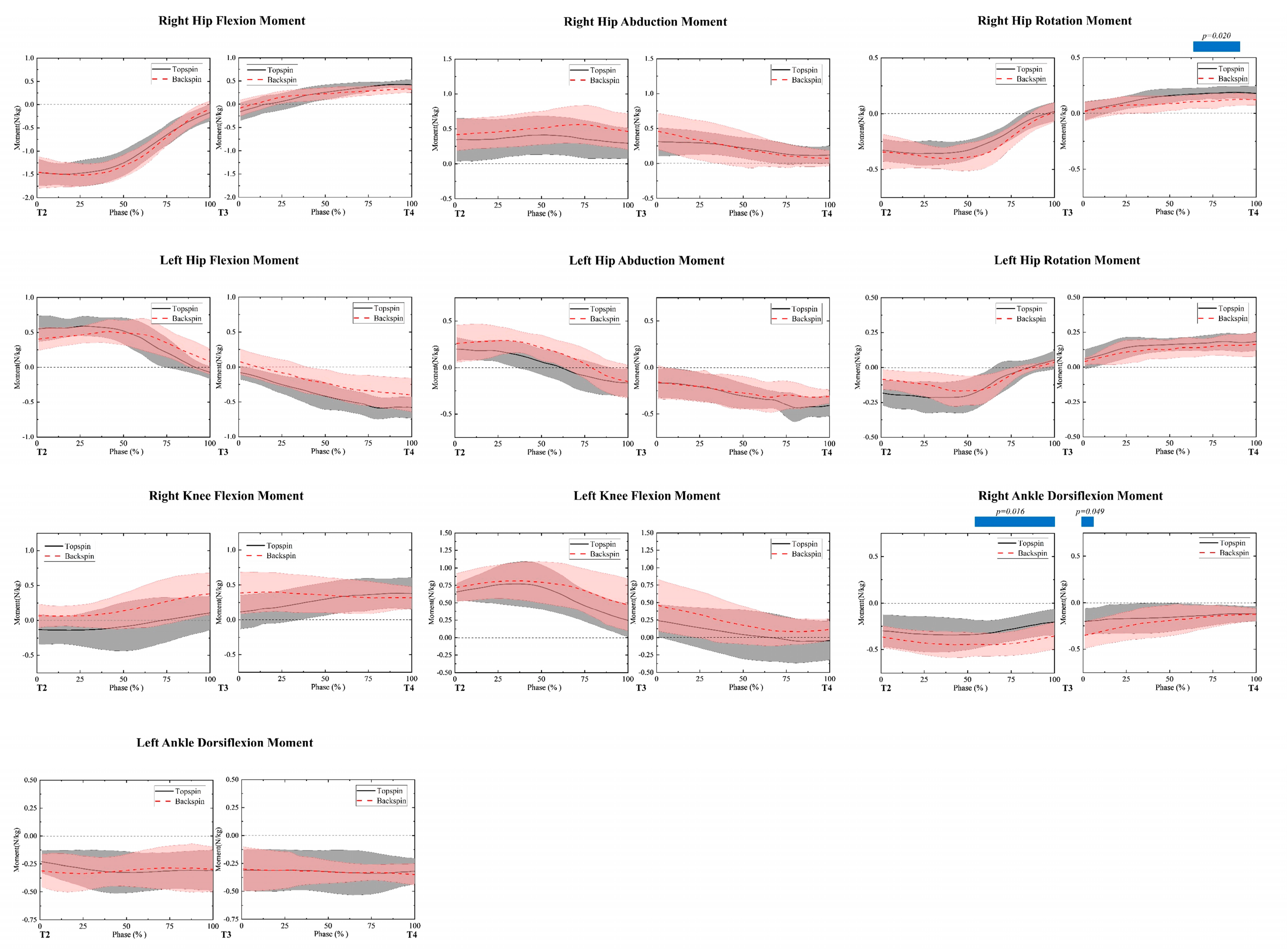A Comparative Biomechanical Analysis of Topspin Forehand against Topspin and Backspin in Table Tennis
Abstract
1. Introduction
2. Materials and Methods
2.1. Participants
2.2. Procedures
2.3. Kinematics and Kinetics
2.4. Data Filtering and Pre-Processing
2.5. Movement Phase Definition
2.6. Statistics Analysis
3. Results
3.1. The Variable of the Center of Gravity and the Joint Angle
3.2. The Variables of the Joint Moment
3.3. Kinematic Analysis of Racket
4. Discussion
4.1. The Backward Swing Phase (T1–T2)
4.2. During the Forward Swing (T2–T3)
4.3. During the Follow-Through (T3–T4)
4.4. Limitations
5. Conclusions
Author Contributions
Funding
Institutional Review Board Statement
Informed Consent Statement
Data Availability Statement
Acknowledgments
Conflicts of Interest
References
- Seemiller, D.; Holowchak, M. Winning Table Tennis: Skills, Drills, and Strategies, 1st ed.; Human Kinetics Publishers: Champaign, IL, USA, 1997. [Google Scholar]
- Lanzoni, I.M.; Di Michele, R.; Merni, F. A notational analysis of shot characteristics in top-level table tennis players. Eur. J. Sport Sci. 2014, 14, 309–317. [Google Scholar] [CrossRef] [PubMed]
- Iino, Y. Hip joint kinetics in the table tennis topspin forehand: Relationship to racket velocity. J. Sports Sci. 2017, 36, 834–842. [Google Scholar] [CrossRef] [PubMed]
- Bańkosz, Z.; Winiarski, S. The kinematics of table tennis racquet: Differences between topspin strokes. J. Sports Med. Phys. Fit. 2018, 57, 202–213. [Google Scholar] [CrossRef]
- Iino, Y.; Kojima, T. Mechanical energy generation and transfer in the racket arm during table tennis topspin backhands. Sports Biomech. 2016, 15, 180–197. [Google Scholar] [CrossRef]
- Iino, Y.; Kojima, T. Kinematics of table tennis topspin forehands: Effects of performance level and ball spin. J. Sports Sci. 2009, 27, 1311–1321. [Google Scholar] [CrossRef] [PubMed]
- Iino, Y.; Kojima, T. Kinetics of the upper limb during table tennis topspin forehands in advanced and intermediate players. Sports Biomech. 2011, 10, 361–377. [Google Scholar] [CrossRef] [PubMed]
- Lanzoni, I.M.; Bartolomei, S.; Di Michele, R.; Fantozzi, S. A kinematic comparison between long-line and cross-court top spin forehand in competitive table tennis players. J. Sports Sci. 2017, 36, 2637–2643. [Google Scholar] [CrossRef] [PubMed]
- Lanzoni, I.M.; Bartolomei, S.; Di Michele, R.; Gu, Y.; Baker, J.S.; Fantozzi, S.; Cortesi, M. Kinematic Analysis of the Racket Position during the Table Tennis Top Spin Forehand Stroke. Appl. Sci. 2021, 11, 5178. [Google Scholar] [CrossRef]
- He, Y.; Lv, X.; Zhou, Z.; Sun, D.; Baker, J.S.; Gu, Y. Comparing the Kinematic Characteristics of the Lower Limbs in Table Tennis: Differences between Diagonal and Straight Shots Using the Forehand Loop. J. Sports Sci. Med. 2020, 19, 522–528. [Google Scholar]
- Zhu, R.; Yang, X.; Chong, L.C.; Shao, S.; István, B.; Gu, Y. Biomechanics of Topspin Forehand Loop in Table Tennis: An Application of OpenSim Musculoskeletal Modelling. Healthcare 2023, 11, 1216. [Google Scholar] [CrossRef]
- Hodges, L. Table Tennis: Steps to Success, 1st ed.; Human Kinetics: Champaign, IL, USA, 1993. [Google Scholar]
- Kidokoro, S.; Inaba, Y.; Yoshida, K.; Yamada, K.; Ozaki, H. A topspin rate exceeding 110 rps reduces the ball time of arrival to the opponent: A table tennis rally study. Sports Biomech. 2022, 1–17. [Google Scholar] [CrossRef] [PubMed]
- Le Mansec, Y.; Dorel, S.; Nordez, A.; Jubeau, M. Sensitivity and Reliability of a Specific Test of Stroke Performance in Table Tennis. Int. J. Sports Physiol. Perform. 2016, 11, 678–684. [Google Scholar] [CrossRef] [PubMed]
- Wu, W.-L.; Liang, J.-M.; Chen, C.-F.; Tsai, K.-L.; Chen, N.-S.; Lin, K.-C.; Huang, I.-J. Creating a Scoring System with an Armband Wearable Device for Table Tennis Forehand Loop Training: Combined Use of the Principal Component Analysis and Artificial Neural Network. Sensors 2021, 21, 3870. [Google Scholar] [CrossRef] [PubMed]
- Xing, K.; Hang, L.; Lu, Z.; Mao, C.; Kang, D.; Yang, C.; Sun, Y. Biomechanical Comparison between Down-the-Line and Cross-Court Topspin Backhand in Competitive Table Tennis. Int. J. Environ. Res. Public Health 2022, 19, 5146. [Google Scholar] [CrossRef]
- Sun, Y.; Wei, S.; Zhong, Y.; Fu, W.; Li, L.; Liu, Y. How Joint Torques Affect Hamstring Injury Risk in Sprinting Swing–Stance Transition. Med. Sci. Sports Exerc. 2015, 47, 373–380. [Google Scholar] [CrossRef]
- Collins, T.D.; Ghoussayni, S.N.; Ewins, D.J.; Kent, J.A. A six degrees-of-freedom marker set for gait analysis: Repeatability and comparison with a modified Helen Hayes set. Gait Posture 2009, 30, 173–180. [Google Scholar] [CrossRef]
- Zhang, Z.; Halkon, B.; Chou, S.M.; Qu, X. A novel phase-aligned analysis on motion patterns of table tennis strokes. Int. J. Perform. Anal. Sport 2017, 16, 305–316. [Google Scholar] [CrossRef]
- Yu, B.; Gabriel, D.; Noble, L.; An, K.-N. Estimate of the Optimum Cutoff Frequency for the Butterworth Low-Pass Digital Filter. J. Appl. Biomech. 1999, 15, 318–329. [Google Scholar] [CrossRef]
- Winter, D.A. Biomechanics and Motor Control of Human Movement, 1st ed.; John Wiley & Sons, Inc.: Hoboken, NJ, USA, 2009. [Google Scholar]
- Cole, G.K.; Nigg, B.M.; Ronsky, J.L.; Yeadon, M.R. Application of the Joint Coordinate System to Three-Dimensional Joint Attitude and Movement Representation: A Standardization Proposal. J. Biomech. Eng. 1993, 115, 344–349. [Google Scholar] [CrossRef]
- Iino, Y.; Kojima, T. Effect of the racket mass and the rate of strokes on kinematics and kinetics in the table tennis topspin backhand. J. Sports Sci. 2016, 34, 721–729. [Google Scholar] [CrossRef]
- Pataky, T.C. One-dimensional statistical parametric mapping in Python. Comput. Methods Biomech. Biomed. Eng. 2012, 15, 295–301. [Google Scholar] [CrossRef] [PubMed]
- Nichols, T.E.; Holmes, A.P. Nonparametric permutation tests for functional neuroimaging: A primer with examples. Hum. Brain Mapp. 2002, 15, 1–25. [Google Scholar] [CrossRef] [PubMed]
- Yang, C.; Bouffard, J.; Srinivasan, D.; Ghayourmanesh, S.; Cantú, H.; Begon, M.; Côté, J.N. Changes in movement variability and task performance during a fatiguing repetitive pointing task. J. Biomech. 2018, 76, 212–219. [Google Scholar] [CrossRef] [PubMed]
- Bańkosz, Z.; Winiarski, S. Statistical Parametric Mapping Reveals Subtle Gender Differences in Angular Movements in Table Tennis Topspin Backhand. Int. J. Environ. Res. Public Health 2020, 17, 6996. [Google Scholar] [CrossRef]
- Lu, Z.; Zhang, X.; Mao, C.; Liu, T.; Li, X.; Zhu, W.; Wang, C.; Sun, Y. Effects of Mobile Phone Use on Gait and Balance Control in Young Adults: A Hip–Ankle Strategy. Bioengineering 2023, 10, 665. [Google Scholar] [CrossRef]
- Lees, A. Science and the major racket sports: A review. J. Sports Sci. 2003, 21, 707–732. [Google Scholar] [CrossRef]
- Komi, P.V. Physiological and biomechanical correlates of muscle function: Effects of muscle structure and stretch-shortening cycle on force and speed. Exerc. Sport Sci. Rev. 1984, 12, 81–122. [Google Scholar] [CrossRef]
- Le Mansec, Y.; Dorel, S.; Hug, F.; Jubeau, M. Lower limb muscle activity during table tennis strokes. Sports Biomech. 2018, 17, 442–452. [Google Scholar] [CrossRef]
- He, Y.; Fekete, G.; Sun, D.; Baker, J.S.; Shao, S.; Gu, Y. Lower Limb Biomechanics during the Topspin Forehand in Table Tennis: A Systemic Review. Bioengineering 2022, 9, 336. [Google Scholar] [CrossRef]
- Wong, D.W.-C.; Lee, W.C.-C.; Lam, W.-K. Biomechanics of Table Tennis: A Systematic Scoping Review of Playing Levels and Maneuvers. Appl. Sci. 2020, 10, 5203. [Google Scholar] [CrossRef]
- Bańkosz, Z.; Winiarski, S. The Evaluation of Changes of Angles in Selected Joints During Topspin Forehand in Table Tennis. Mot. Control 2018, 22, 314–337. [Google Scholar] [CrossRef] [PubMed]
- Bańkosz, Z.; Winiarski, S. Correlations between Angular Velocities in Selected Joints and Velocity of Table Tennis Racket during Topspin Forehand and Backhand. J. Sports Sci. Med. 2018, 17, 330–338. [Google Scholar] [PubMed]
- Tang, D.; Zeng, O.; Leng, L. Robustness and Menace of Backspin and its Physical Principle. J. Wuhan Inst. Phys. Educ. 2013, 47, 85–92. [Google Scholar] [CrossRef]
- Tsai, C.; Pan, K.; Huang, K.; Chang, T.; Hsueh, Y.; Wang, L.; Chang, S. The surface emg activity of the upper limb muscles in table tennis forehand drives. In Proceedings of the Proc XXVIII Int Symp Biomech Sport, Marquette, MI, USA, 19–23 July 2010; Volume 1, pp. 305–308. [Google Scholar]






| Racket Velocity (m/s) | AT (Mean ± SD) | AB (Mean ± SD) | p | ES |
|---|---|---|---|---|
| X component value | 10.35 ± 0.88 | 8.27 ± 2.01 | 0.028 * | 0.973 |
| Y component value | 4.26 ± 1.85 | 2.81 ± 2.33 | 0.037 * | 0.906 |
| Z component value | 7.62 ± 0.93 | 11.70 ± 0.68 | 0.001 ** | 6.210 |
| The resultant value | 13.67 ± 0.90 | 14.83 ± 1.55 | 0.023 * | 1.026 |
| Angle Variable | AT (Mean ± SD) | AB (Mean ± SD) | p | ES |
|---|---|---|---|---|
| T2 | ||||
| XY plane (°) | 47.3 ± 17.7 | 66.9 ± 20.5 | 0.007 ** | 1.336 |
| YZ plane (°) | 56.9 ± 14.5 | 42.0 ± 17.0 | 0.001 ** | 3.096 |
| XZ plane (°) | 69.1 ± 22.5 | 63.6 ± 16.2 | 0.291 | 0.404 |
| T3 | ||||
| XY plane (°) | 58.5 ± 6.0 | 74.7 ± 5.4 | 0.001 ** | 2.538 |
| YZ plane (°) | 34.6 ± 5.3 | 18.7 ± 2.9 | 0.001 ** | 3.074 |
| XZ plane (°) | 82.6 ± 11.0 | 81.1 ± 4.1 | 0.067 | 0.159 |
| Distance Variable (m) | AT (Mean ± SD) | AB (Mean ± SD) | p | ES |
|---|---|---|---|---|
| X component-backward swing | 0.72 ± 0.24 | 0.30 ± 0.18 | 0.001 ** | 2.550 |
| Y component-backward swing | 0.27 ± 0.17 | 0.34 ± 0.15 | 0.402 | 0.315 |
| Z component-backward swing | 0.29 ± 0.17 | 0.13 ± 0.10 | 0.042 * | 0.876 |
| Resultant-backward swing | 0.88 ± 0.32 | 0.51 ± 0.21 | 0.008 ** | 1.311 |
| X component-forward swing | 0.91 ± 0.18 | 0.82 ± 0.16 | 0.083 | 0.715 |
| Y component-forward swing | 0.63 ± 0.25 | 0.84 ± 0.27 | 0.002 ** | 1.754 |
| Z component-forward swing | 0.54 ± 0.11 | 0.72 ± 0.12 | 0.009 ** | 1.280 |
| Resultant-forward swing | 1.36 ± 0.31 | 1.54 ± 0.29 | 0.028 * | 0.975 |
| X component-follow-through | 0.41 ± 0.09 | 0.37 ± 0.10 | 0.512 | 0.244 |
| Y component-follow-through | 0.82 ± 0.05 | 0.89 ± 0.15 | 0.383 | 0.330 |
| Z component-follow-through | 0.46 ± 0.10 | 0.62 ± 0.10 | 0.002 ** | 1.660 |
| Resultant-follow-through | 1.11 ± 0.10 | 1.25 ± 0.15 | 0.051 | 0.832 |
Disclaimer/Publisher’s Note: The statements, opinions and data contained in all publications are solely those of the individual author(s) and contributor(s) and not of MDPI and/or the editor(s). MDPI and/or the editor(s) disclaim responsibility for any injury to people or property resulting from any ideas, methods, instructions or products referred to in the content. |
© 2023 by the authors. Licensee MDPI, Basel, Switzerland. This article is an open access article distributed under the terms and conditions of the Creative Commons Attribution (CC BY) license (https://creativecommons.org/licenses/by/4.0/).
Share and Cite
Mao, C.; Liu, T.; Li, X.; Lu, Z.; Li, Z.; Xing, K.; Chen, L.; Sun, Y. A Comparative Biomechanical Analysis of Topspin Forehand against Topspin and Backspin in Table Tennis. Appl. Sci. 2023, 13, 8119. https://doi.org/10.3390/app13148119
Mao C, Liu T, Li X, Lu Z, Li Z, Xing K, Chen L, Sun Y. A Comparative Biomechanical Analysis of Topspin Forehand against Topspin and Backspin in Table Tennis. Applied Sciences. 2023; 13(14):8119. https://doi.org/10.3390/app13148119
Chicago/Turabian StyleMao, Chuangui, Tao Liu, Xinglu Li, Zijun Lu, Zhengao Li, Kaige Xing, Lixia Chen, and Yuliang Sun. 2023. "A Comparative Biomechanical Analysis of Topspin Forehand against Topspin and Backspin in Table Tennis" Applied Sciences 13, no. 14: 8119. https://doi.org/10.3390/app13148119
APA StyleMao, C., Liu, T., Li, X., Lu, Z., Li, Z., Xing, K., Chen, L., & Sun, Y. (2023). A Comparative Biomechanical Analysis of Topspin Forehand against Topspin and Backspin in Table Tennis. Applied Sciences, 13(14), 8119. https://doi.org/10.3390/app13148119








